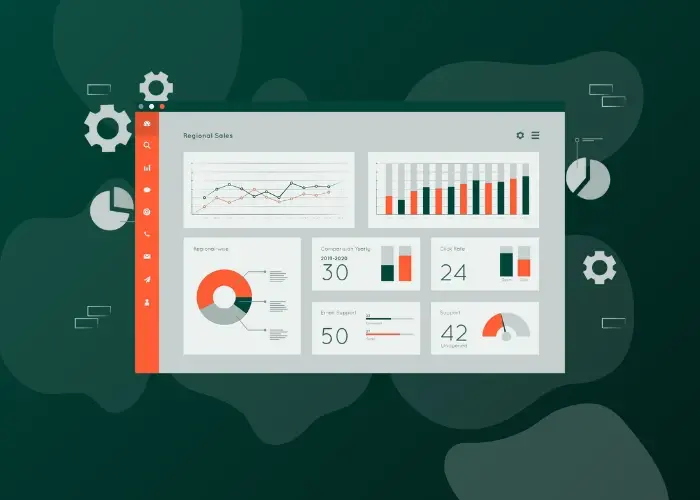11 HubSpot Dashboard Examples Every Company Should Use
Explore 11 powerful HubSpot dashboard examples designed to empower businesses of all sizes and industries with actionable insights.

Explore the top 7 HubSpot marketing dashboards to streamline your marketing strategy, enhance ROI, and make data-driven decisions with custom dashboards.
With HubSpot’s dashboard and analytics tools, marketers can leverage real-time data to enhance strategic decisions and optimize ROI. Many marketing dashboards, however, can become too complex, resulting in underutilization. HubSpot’s analytics simplify this by providing real-time metrics on campaign effectiveness and areas for improvement, helping marketers adapt strategies quickly in the dynamic digital landscape of 2025.
In this blog, we’ll explore seven key marketing dashboard examples that streamline the creation process, enhance insight discovery, and promote best practices in dashboard design, saving time and boosting consistency and efficiency.
The Overall Marketing Performance Dashboard provides a comprehensive view of a marketing ecosystem, enabling marketers to make data-driven decisions and streamline success. This dashboard offers insights into the entire conversion funnel, key performance indicators (KPIs), and other essential digital marketing metrics, allowing for the automation of manual reporting tasks.
With each marketing touchpoint assigned a tangible value, this dashboard helps marketers evaluate the success of their campaigns through reports such as:
Traffic Reports: Show sources of web traffic, such as organic search, paid ads, social media, referrals, and direct visits. This helps identify which channels are driving the most traffic.
Conversion Reports: Detail the conversion rates across different sales funnel stages, and lifecycle stages, from initial contact to final sale. These can be broken down by marketing channels to see which are most effective at converting leads.
Lead Generation Reports: Track the number of leads generated over a specific period and their sources. This can include detailed demographics, lead scoring, or behavioral data to understand lead quality better.
Channel Effectiveness Reports: Provide insights into which marketing channels (e.g., email, social media, PPC) are performing best in reaching and converting target audiences.
ROI Reports: Calculate the return on investment for different marketing campaigns, factoring in costs like ad spend, manpower, and other resources against the revenue generated.
This dashboard not only gives marketers a panoramic view of all marketing activities and their impact on business outcomes but also allows for a quick assessment of the health of marketing initiatives.

A Content Strategy Insight Dashboard helps marketers evaluate the performance of their content strategy and fine-tune their approach for maximum impact.
To gain insights into what content types are performing well and identify areas for improvement there’s a need to analyze key metrics such as page views, engagement metrics, lead conversions from content, and SEO performance. By analyzing key reports, marketers can gain insights into what content types are performing well and identify areas for improvement.
Page Views: By analyzing page views you’ll have a quantitative measure of how many times a content has been accessed by users. Marketers can measure the popularity and reach of their content by tracking page views that help identify top-performing content.
Engagement Metrics: With engagement metrics, marketers can asses time spent on a page, scroll depth, and social shares that offer qualitative insights into the interaction of audiences with content.
Lead Conversions from Content: Measuring the effect of content on lead generation requires tracking lead conversions that are directly linked to specific content pieces. Whether it's through a demo request, webinar registration, or the download of a gated resource, tracking lead conversions offers concrete proof of how well content motivates action.
Marketers can fine-tune their content strategy for maximum engagement and lead generation using a content strategy insight dashboard by analyzing key metrics such as page views.

The Social Media Overview Dashboard serves as a central hub to track performance across various platforms and guide social media strategy with actionable insights.
This dashboard provides marketers with a comprehensive view of their performance across social platforms. The data collected from platforms like Facebook, Instagram, Twitter, LinkedIn, and more, help marketers track key metrics and analyze trends to inform their social media strategy effectively.
Engagement Rates: Engagement helps in measuring the level of interaction (likes, comments, shares, and other forms of interaction) and involvement with your social media content. By tracking engagement rates across platforms, marketers can understand how well their content resonates with their audience and identify opportunities for improvement.
Follower Growth: Gaining more followers gives you valuable information about how your social media following is growing over time. Marketers can evaluate the success of their content strategy, audience targeting, and promotional efforts in drawing in and keeping followers by keeping an eye on follower growth rates across all platforms.
Top-Performing Posts: By identifying the posts that perform best, marketers can determine the type of content that resonates with their audience the most and create similar campaigns in the future. Marketers can identify trends, themes, and content formats that generate the highest levels of engagement and return on investment by examining metrics like reach, engagement, and conversion rates.
Actionable audience behavior insights from the Social Media Overview Dashboard are invaluable in guiding social media strategy. This dashboard gives marketers a comprehensive understanding of social media performance, allowing them to Identify high-performing content and replicate success in future campaigns.

The Email Campaign Analysis Dashboard within HubSpot helps in assessing the impact and effectiveness of email marketing campaigns. The main goal of the dashboard is to give marketers actionable insights into how their email campaigns are performing and how much they are connecting with their target audience.
Open Rates: The percentage of recipients who open the email is indicated by this metric. While a low open rate can point to the need for optimization, a high open rate shows that the content and subject line are appealing.
Click Rates: The percentage of recipients who clicked on email links is indicated by the click rate. This metric calculates the engagement level and interest generated by the email content.
Unsubscribe Rates: The percentage of recipients who chose not to receive further emails from the campaign after receiving it is measured by unsubscribe rates.
Conversion Rates: These measures indicate what proportion of email recipients completed a desired action like buying something or completing a form after interacting with the message. These reports are not directly available in email analytics but can managed via workflows if workflow goals are set up.
The Email Campaign Analysis Dashboard holds immense importance for marketers for several reasons such as identifying high-performing campaigns, highlighting areas for improvement, optimizing email content strategy, and maximizing ROI.

The SEO Performance Dashboard guides marketers regarding SEO strategies and tactics, to maximize organic reach and drive meaningful engagement.
This dashboard's main goal is to track important SEO metrics that have a direct impact on organic reach. By monitoring these metrics, marketers can obtain important insights into the success of their SEO campaigns and spot areas for optimization.
Organic Traffic: Measures the number of visitors who arrive at your site through unpaid search engine results.
Click-Through Rates (CTR): Indicates the percentage of people who click on a link or advertisement after seeing it.
Bounce Rates: This represents the percentage of visitors who leave the site after viewing only one page, without any interactions.
The SEO Performance Dashboard is not just a collection of metrics that help drive traffic and improve site visibility. Monitoring SEO performance is essential for staying ahead of the curve as it provides valuable insights to marketers so they can fine-tune their SEO strategies, and optimize website content, that enhances organic reach, drives meaningful engagement, and delivers tangible results.

Examining the profitability of paid marketing efforts is the main goal of the Paid Campaigns ROI Dashboard. Businesses looking to make the most of their marketing budget must analyze the return on investment of paid campaigns because every dollar spent on advertising matters. Some of these stats and reports are not available in HubSpot dashboard tools but they have a dedicated dashboard in the Ads tool.
Cost per Acquisition (CPA): Measures the average cost incurred for acquiring paying customers from a marketing campaign.
Click-Through Rate (CTR): Indicates the percentage of people who click on a specific link or advertisement relative to the number of total viewers.
Unengaged Paid Search Contacts Report: An unengaged paid search contacts report shows leads from paid campaigns on platforms like LinkedIn, Bing, and Google that haven't been contacted by sales. It helps marketers and sales teams see where unengaged leads come from, so they can prioritize outreach and improve follow-up strategies.
Demos Booked through Each Paid Campaign: A "demos booked through each campaign" report shows how many product demos are scheduled from leads on platforms like LinkedIn, Bing, and Google. It helps marketers see which campaigns work best, so they can improve spending and strategies for better results.
Optimizing ad spending across platforms and guiding strategic decision-making are critical functions of the Paid Campaigns ROI Dashboard. It is important for not just optimizing Ad spending but also for identifying profitable channels, improving campaign performance, and driving strategic decision-making.

The lead generation and conversion dashboard is a tool that acts as a compass, pointing marketers precisely and clearly in the direction of their goals.
With this dashboard, marketers can see all the details of their lead generation process, from acquiring new leads to turning them into paying clients. They can discover opportunities for optimization and weaknesses in lead generation strategies by monitoring their performance in real time, which can ultimately lead to improved outcomes and ROI maximization.
Within the Lead Generation and Conversion Dashboard, the following key metrics take center stage, offering valuable insights into the effectiveness of the lead generation funnel:
Number of New Leads: Tracks the total number of potential customers acquired during a specific period.
Lead Sources: Identifies the origins or channels through which new leads are generated.
Lead Conversion Rate: Measures the percentage of leads that successfully convert into customers or achieve a desired action.
Through precise observation of critical metrics like the number of fresh leads, lead origins, lead conversion ratio, and cost per lead, marketers can make informed decisions based on data, refine their approaches, and ultimately produce a greater number of qualified leads at a reduced expense.
%20(700%20x%20360%20px)%20(700%20x%20400%20px).webp?width=680&height=389&name=Untitled%20(700%20x%20340%20px)%20(700%20x%20360%20px)%20(700%20x%20400%20px).webp)
Source: HubSpot
HubSpot marketing dashboards emerge as a game-changing strategy for marketers seeking to elevate their performance and drive results. Using HubSpot marketing dashboard examples becomes a game-changing tactic for marketers looking to improve their performance and produce results in the dynamic world of digital marketing in 2024.
These dashboards help marketers streamline their efforts and enhance decision-making in several ways including streamlined insights, data-driven decision-making, optimized performance, enhanced accountability, customization, and scalability. Take advantage of this opportunity, personalize your dashboards, and set out on a path to marketing greatness with HubSpot.
-1.webp?format=webp&width=400&height=250&name=HubSpot%20Dashboard%20Examples%20(2)-1.webp)
Explore 11 powerful HubSpot dashboard examples designed to empower businesses of all sizes and industries with actionable insights.

Explore 14 must-use HubSpot sales dashboard examples and best practices for tracking key metrics and optimizing performance.

Automate your marketing efforts with these marketing workflow examples that streamline tasks, improve lead nurturing, and enhance customer engagement.